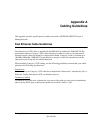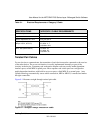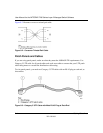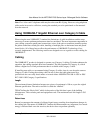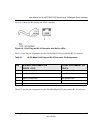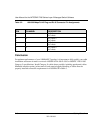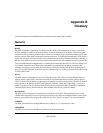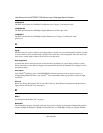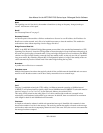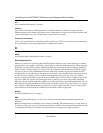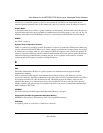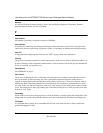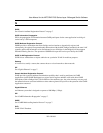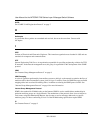
Glossary B-1
202-10010-01
Appendix B
Glossary
Use the list below to find definitions for technical terms used in this manual.
Numeric
802.1D
The IEEE designator for Spanning Tree Protocol (STP). STP, a link management protocol, is part of the
802.1D standard for media access control bridges. Using the spanning tree algorithm, STP provides path
redundancy while preventing endless loops in a network. An endless loop is created by multiple active paths
between stations where there are alternate routes between hosts. To establish path redundancy, STP creates a
logical tree that spans all of the switches in an extended network, forcing redundant paths into a standby, or
blocked, state. STP allows only one active path at a time between any two network devices (this prevents the
loops) but establishes the redundant links as a backup if the initial link should fail. If STP costs change, or if
one network segment in the STP becomes unreachable, the spanning tree algorithm reconfigures the
spanning tree topology and reestablishes the link by activating the standby path. Without spanning tree in
place, it is possible that both connections may be simultaneously live, which could result in an endless loop
of traffic on the LAN.
802.1P
The IEEE protocol designator for Local Area Network (LAN). This Layer 2 network standard improves
support of time critical traffic, and limits the extent of high bandwidth multicast traffic within a bridged
LAN. To do this, 802.1P defines a methodology for introducing traffic class priorities. The 802.1P standard
allows priority to be defined in all 802 MAC protocols (Ethernet, Token Bus, Token Ring), as well as in
FDDI. For protocols (such as Ethernet) that do not contain a priority field, 802.1P specifies a method for
indicating frame priority based on the new fields defined in the 802.1Q (VLAN) standard.
802.1Q VLAN
The IEEE protocol designator for Virtual Local Area Network (VLAN). This standard provides VLAN
identification and quality of service (QoS) levels. Four bytes are added to an Ethernet frame to allow eight
priority levels (QoS) and to identify up to 4096 VLANs. See “VLAN” on page 17 for more information.
10BASE-T
The IEEE specification for 10 Mbps Ethernet over Category 3, 4, or 5 twisted-pair cable.
100BASE-FX
The IEEE specification for 100 Mbps Fast Ethernet over fiber-optic cable.



